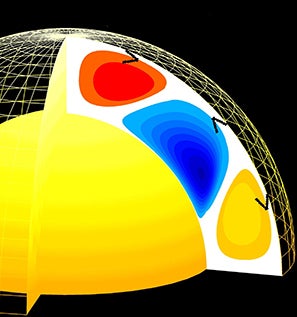Next step toward predicting Sun’s cycles
Solar scientists take a page from weather forecasters
Aug 5, 2014 - by Staff
Aug 5, 2014 - by Staff
August 6, 2014 | A leading goal of solar scientists is to improve predictions of the Sun’s approximately 11-year cycle. The research is motivated in part by the costs of solar storms that eject massive clouds of charged plasma particles toward Earth, especially during and following peaks in the cycle. Severe solar weather can knock satellites and power grids offline and disrupt communications and navigational systems.
A new study, led by scientists at the National Center for Atmospheric Research (NCAR) in collaboration with the Nordic Institute for Theoretical Physics (NORDITA), shows how solar predictions can borrow from weather forecasting techniques in order to predict the timing and extent of the solar cycle.
For the better part of a decade, solar scientists have hypothesized that the solar cycle and related solar storms are largely influenced by a mysterious current of plasma, or electrified gas, that flows from the Sun’s lower latitudes toward its poles. In 2006, a team of researchers led by NCAR scientist Mausumi Dikpati drew on their theory of solar cycle evolution, including this meridional circulation, to predict that the coming solar cycle would be delayed but stronger than average, producing a high number of sunspots and solar storms. Although the cycle did get off to a late start, it has been unusually weak.

An example of model-produced meridional circulation beneath the solar surface, showing a complex flow pattern in depth and latitude. In the vertical cross section at upper right, the flow is clockwise (red), counterclockwise (blue), and weaker clockwise (yellow). Outputs vary from model to model, and observations have not yielded a consensus on a unique circulation pattern across space and time. (Image courtesy Mausumi Dikpati.)
Dikpati hypothesizes that the reason has to do with the complex nature of the meridional flow. Instead of moving monolithically, as a single cell, she and other scientists now believe the flow is more variegated, sometimes consisting of several cells that may move at different speeds or sink to lesser subsurface depths in the Sun’s northern and southern hemispheres.
But predicting the flow—and associated solar activity—is not readily possible with existing technologies. The flow cannot be observed during the times when it leaves the lower latitudes and sinks beneath the Sun’s surface, nor can it be adequately simulated by computer models, both because of limits on computing power available for solar prediction and because the flow’s movements are not entirely understood.
To flesh out the picture for the new study, Dikpati and her co-authors have drawn on a third tool: data assimilation. This technique, an integral part of weather forecasting, continually incorporates observations into a computer model and uses statistical techniques to enable more reliable predictions of future events. The NCAR Data Assimilation Research Testbed is the center’s flagship facility for this technique. DART gave the authors the tool they needed because it is designed to be readily adapted to various applications.
The research team ran a series of model simulations on NCAR’s advanced supercomputer, known as Yellowstone. The team created a small number of synthetic observations of solar magnetism, based on guidance from current observations of the flow speed. Using these, the team demonstrated that it is possible to infer variations in the meridional circulation pattern as well as its amplitude, along with associated evolution of the magnetic fields. As the number of observations is increased from a few to nearly 200 (which still falls short of representing the full range of solar latitudes and flow depths), the meridional flow can be reconstructed with substantially improved accuracy.
“Data assimilation is a critical tool in this area since it is so difficult to observe the interior of the Sun and so challenging to model it,” Dikpati said. “Knowledge from observations, models, and data assimilation—all three together—will complete our knowledge of meridional circulation in the Sun.”
Dikpati said her next step will be to apply this technique retrospectively, seeing if it can infer the entire pattern of the Sun’s meridional circulation in space and time using data from NASA’s SOHO (Solar and Heliospheric Observatory) and SDO (Solar Dynamics Observatory) missions.
Dikpati, Mausumi; Anderson, Jeffrey L.; Mitra, Dhrubaditya (2014), Ensemble Kalman filter data assimilation in a Babcock-Leighton solar dynamo model: An observation system simulation experiment for reconstructing meridional flow-speed, Geophysical Research Letters, doi:10.1002/2014GL061077
|
Writer/contact Collaborating institutions |
Funders |